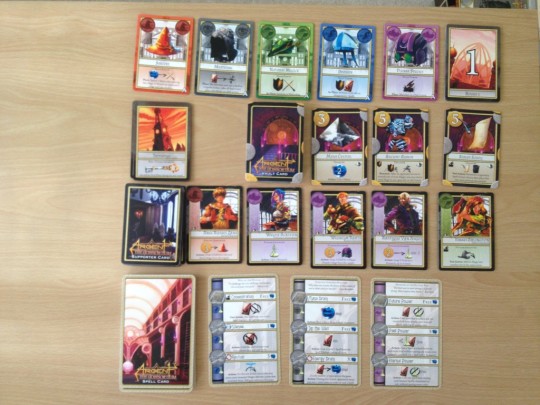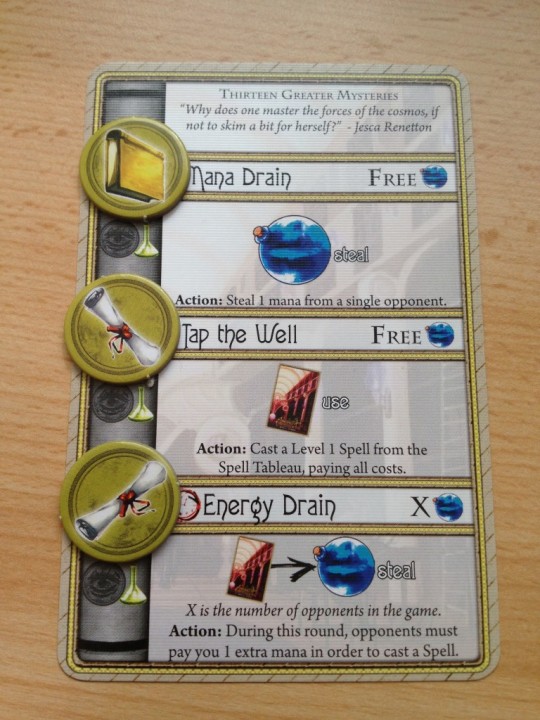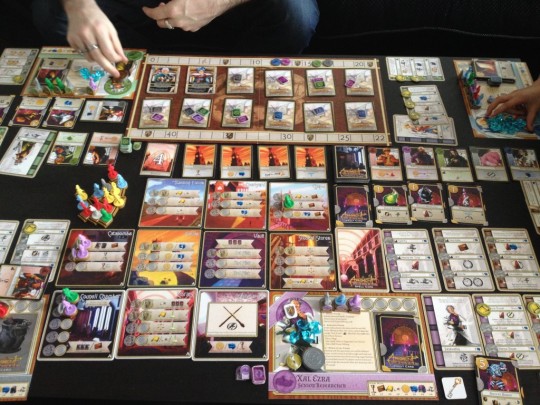Argent: The Consortium is a worker placement game.
Title: Argent: The Consortium
Year Published: 2015
Designer: Trey Chambers
Publisher: Level 99 Games
Players: 2-5
Game Time: ~120 Mins
Set-up Time: >10 Mins
Ages: 12+
Theme: Fantasy School of Magic
Mechanic: Worker Placement
How to win: Gain the most votes from Consortium voters.
Game Description
The time has come for the selection of a new Chancellor at Argent University of Magic, and you are among the likely candidates for the job. Gather your apprentices, ready your spellbook, and build your influence, while secretly discovering and competing over the votes of a limited Consortium of influential board members. Only the one who is able to fulfil the most criteria will be to claim the title of the most influential mage in the World of Indines!
Set-Up
Set-up can vary greatly from game to game so I’ll just go through the basic ‘suggested’ first game from the Argent: The Consortium rulebook. Also, this game has lots of little rules so I won’t cover all the details, just the main stuff.
First, Lay out the Argent University of Magic. The positions of the tiles matter so the wonky-looking layout is on purpose.

Now the cards… Put the Mage Power cards out as reference sheets and put the Bell Tower cards near the consortium board. Put the round cards with 1 on top, and 5 on the bottom then shuffle the spells, vaults, and supporters. Reveal 3 from the Spell and Vault deck and 5 from the supporters. Is your table big enough?

In reverse player, choose a candidate sheet and gather all their starting stuff. Each has a different ability, or you can pick by colour.

Then, starting in reverse player order again, snake draft Mages until everyone has 5.

Everyone puts their influence markers on 5 points in reverse turn order. This puts the last place on the bottom. It’s important to remember that position matters on this track.
Voters
10 of the 12 voters are random, and 2 are in every game. In turn order, place a marker on a face downvoter. No two players can mark the same voter during this phase. You can look at the voter you have marked at any time during the game.
There are 5 categories of Voters…
Most of a Resource – Influence, Mana, Gold, Marks on the board and Intelligence and Wisdom. Also, the Second most Influence and Supporter.

Most of the Card Types – Consumables, Treasure and Supporters.

Most Departmental Control – Icons on all non-starter cards and spells are worth their level. This will make sense later.

Most Research – Total combined levels of all research used.

Most Diversity – Different symbols in supporters and spells.

You’re not entirely sure which are going to be used though so it’s best to diversify and watch other players.
Argent: The Consortium Game Play
A game is played over 5 rounds (known as Days) and is divided into 3 steps. Set Up, Errands and Resolution.
Set up Phase – Skipped in the 1st round
Untap cards, un-flip tokens, return and reveal a new layout of cards and perform room set-up effects. Typical set-up phase stuff.
Errands Phase
In turn order, you MAY take one fast action and MUST take one regular action.
A fast action is an ability with a Lightning Bolt, the purple Planar Mages can also be played as a fast action.
There are a few things you can do as a regular action.
Cast a Spell
Pay mana and tap the spell card to perform the effects of any one spell you have.

Place a Mage
Put a mage in a space in a room, worker-placement style. You do not resolve the action for the room yet, but you do resolve the action of the Mage… There are 6 mages, each with a different colour and ability.

Beige – Neutral – No Power (Told you they’re useless ;))
Red – Sorcery – Spend one mana to wound a mage and take their slot. The wounded mage is sent to the Infirmary.
Grey – Mysticism – Can be placed when a regular spell is cast. So you can cast a spell and play this mage as one regular action.
Green – Natural – Can’t be wounded by the Red mage or spells and abilities that cause wounds.
Purple – Planar – Can be placed as a fast action as I mentioned earlier.
Blue – Divinity – Cannot be affected by spells by rivals.
Not only do the mages have an ability, the spaces you place them onto do too.

Blank Errand Slot – No restrictions, just a regular space.
Merit Slot – (The Shield) Requires a refreshed Merit badge to activate.
Shadow Slot – (The Ghost) Must be shadowed to place here using a Spell or ability and activates after Mage in the regular slot.
Shadow Merit – (Ghost and Shield) Requires both a refreshed Merit badge AND a Shadow effect.
Use a Vault Card
Indicated on the card when it can be used and how to use it. A consumable is discarded into your personal discard pile after use. A Treasure is tapped after use and can be used every round.

Use a Supporter Card
These are always one-use cards and are discarded into your personal discard pile after use.

Take Bell Tower Offering Card
Nothing left to do or want to delay your action a round? You can take pick any one of these cards and get the reward. Taking one IMMEDIATELY ends your turn, even if you have other actions left. You are still in the game for the round and can continue to take actions including more Bell Tower cards.

Resolution Phase
As soon as the last Bell Tower card is taken the round ends immediately. You resolve the rooms actions starting at the top left tile and going top to bottom 1 mage at a time. To activate a space or “Resolve an Errand” you need to pay costs, including merits, then gain the effect and return the mage to your office.

Game End
After the 5th round, reveal all the Consortium voters and determine who receives the vote for each one. Influence Points break ties with the player at the bottom of the stack counting as ‘ahead’, which is why it’s important to keep track of the stack. If nobody has anything for the voter, the voter abstains… The player with the most votes winning, Influence breaks this tie too.
Argent: The Consortium Round-Up
Firstly, some quick info on Research, intelligence and Wisdom.
Intelligence (Book Tokens) determines the number of spells you can memorise while Wisdom (Scroll Tokens) determines the number of spell levels you can possess.

Research (Flask Symbol) lets you draft a new spell or upgrade an old one when it is gained. When you learn a new spell, put an Intelligence token from your supply on the learn slot and you can upgrade a spell with a Wisdom token.

As for the game, wow are there a lot of board combinations! You have 3 tiles in every game (which are double-sided) but the rest are placed around those, they’re different and double-sided… Loads of options.
Spaces
Some have different types of spaces on the board you activate immediately rather than the Resolution Phase… More variety and added gameplay.
Add to that not knowing which Consortium members will be in the game and the re-playability is amazing.
Did I mention the cards used for the Mage abilities are double-sided too?
So, luckily after all of this actual gameplay is good too 🙂 It’s nice to have a Euro game with resources such as Mana, Wisdom and Intelligence rather than Wheat and Stone again. The magical theme and the cool art and bright colours make this my kind of Euro. Although it is a bit evil 🙂
Argent: The Consortium Rating
Fantastic worker placement game with a TONNE of re-playability.
I give it 7/10
Argent: The Consortium Initial Impressions May 2015
Actually, I waited for the second/third play for this one.
There’s a lot to it!

I usually just have one play before writing anything. But Argent: The Consortium is quite big with lots of bits, plus, I won the first game we played and I didn’t feel I deserved it. I generally don’t like that so I wanted to play it again to see if it was a fluke. The second game I played bad and lost, in the third game I played well and won. So I’m happy about that.

So, I really like Argent: The Consortium. There’s a lot to it in a fairly compact box. I’ve played it 3 times and only ever used the base set up so it’ll be interesting using some of the other tiles available. I’m also looking forward to using alternate versions of the mage abilities.

There is a large expansion available which adds even more stuff, including the 7th colour of mage which is interesting.
But for now, at least I’m very happy with the base game of Argent: The Consortium.
Jesta ThaRogue


Leave a Reply